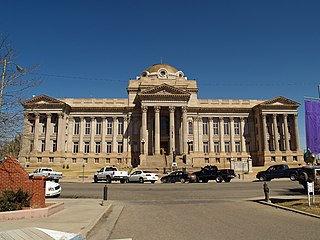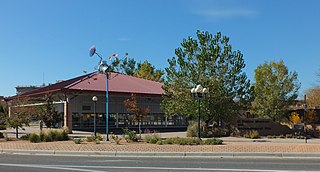
Pueblo is a home rule municipality that is the county seat and the most populous municipality of Pueblo County, Colorado, United States. The city population was 111,876 at the 2020 United States Census, making Pueblo the ninth most populous city in Colorado. Pueblo is the principal city of the Pueblo, CO Metropolitan Statistical Area and a major city of the Front Range Urban Corridor.

Pueblo County is a county located in the U.S. state of Colorado. As of the 2020 census, the population was 168,162. The county seat is Pueblo. The county was named for the historic city of Pueblo which took its name from the Spanish language word meaning "town" or "village". Pueblo County comprises the Pueblo, CO Metropolitan Statistical Area.

Cañon City is a home rule municipality that is the county seat and the most populous municipality of Fremont County, Colorado, United States. The city population was 17,141 at the 2020 United States Census. Cañon City is the principal city of the Cañon City, CO Micropolitan Statistical Area and is a part of the Front Range Urban Corridor. Cañon City straddles the easterly flowing Arkansas River and is a popular tourist destination for sightseeing, whitewater rafting, and rock climbing. The city is known for its many public parks, fossil discoveries, Skyline Drive, The Royal Gorge railroad, the Royal Gorge, and extensive natural hiking paths. In 1994, the United States Board on Geographic Names approved adding the tilde to the official name of Cañon City, a change from Canon City as the official name in its decisions of 1906 and 1975. It is one of the few U.S. cities to have the Spanish Ñ in its name, others being La Cañada Flintridge, California; Española, New Mexico; Peñasco, New Mexico; and Peñitas, Texas.

Mancos is a statutory town in Montezuma County, Colorado, United States. The population was 1,196 at the 2020 census, down from 1,336 in 2010.

Pueblo West is a census-designated place (CDP) in and governed by Pueblo County, Colorado, United States. The CDP is part of the Pueblo, CO Metropolitan Statistical Area. The population of the Pueblo West CDP was 33,086 according to the United States Census 2020. The Pueblo West Metropolitan District provides services. The Pueblo post office (Zip Code 81007) serves Pueblo West postal addresses.
Kenton is a neighborhood in the north section of Portland, Oregon, United States. The neighborhood was originally a company town founded in 1911 for the Swift Meat Packing Company.

Centennial High School is a high school located in Pueblo, Colorado, United States. It serves roughly 1000 students in grades 9 through 12. The school is a part of Pueblo School District 60.

Victor Downtown Historical District is a 22 acres (8.9 ha) historic district encompassing several blocks of Victor, Colorado which was listed in the National Register of Historic Places in 1985. The listing included 55 contributing buildings out of 66 buildings in total. The district is bounded roughly by Diamond Avenue, Second, Portland and Fifth Streets.

Old Colorado City, formerly Colorado City, was once a town, but it is now a neighborhood within the city of Colorado Springs, Colorado. Its commercial district was listed on the National Register of Historic Places in 1982. It was founded during the Pikes Peak Gold Rush of 1859 and was involved in the mining industry, both as a supply hub and as a gold ore processing center beginning in the 1890s. Residents of Colorado City worked at some of the 50 coal mines of the Colorado Springs area. It was briefly the capital of the Colorado Territory. For many years, Colorado Springs prohibited the use of alcohol within its border due to the lifestyle of Colorado City's opium dens, bordellos, and saloons. It is now a tourist area, with boutiques, art galleries, and restaurants.

The Historic Arkansas Riverwalk is a riverwalk in the city of Pueblo, Colorado, along the Arkansas River. The riverwalk was constructed as part of an effort to attract tourists and trade to the city. The riverwalk features history about the Pueblo Flood of 1921, and also hosts recreation and restaurants.
The University of Arkansas Campus Historic District is a historic district that was listed on the National Register of Historic Places on September 23, 2009. The district covers the historic core of the University of Arkansas campus, including 25 buildings.
Bessemer, Colorado was a city in Colorado that was incorporated in 1886. The community was named after Henry Bessemer, an English inventor. It was one of four adjacent towns settled after the Colorado Gold Rush of 1859. The communities of South Pueblo, Central Pueblo, Pueblo, and Bessemer were later merged to create the modern City of Pueblo, Colorado. Bessemer was an independent city until 1894 and was the last city to join Pueblo. The former community of Bessemer is sometimes now referred to as the Bessemer neighborhood. Its also known as the Bessemer area. The Bessemer area is home to both Bessemer Academy and Ray Aguilera Park.

El Pueblo History Museum is a local history museum in Pueblo, Colorado, United States. The museum presents the history of Pueblo, together with the cultural and ethnic groups of the region. The historical site includes an 1840s-style adobe trading post and plaza and the archaeological excavation site of the original 1842 El Pueblo trading post which was listed on the US National Register of Historic Places in 1996. The facility is administered by History Colorado.

Veterans' Bridge is a $1.5 million pedestrian footbridge and monument honoring all veterans regardless of branch of military service or whether they served in peace time or war. The bridge — located on the Historic Arkansas Riverwalk of Pueblo — was formally opened and dedicated to the public on Veterans Day, November 11, 2010.

Manitou Springs Historic District in Manitou Springs, Colorado is roughly bounded by US 24, Ruxton Avenue, El Paso Boulevard and Iron Mountain Avenue. Listed in the National Register of Historic Places, it is one of the country's largest National Historic Districts.

The Atkins Commercial Historic District encompasses the historic business district of Atkins, Arkansas. It extends for two blocks on Main Street and 1st Street, between Church and 2nd Avenues. This area was largely developed between 1890 and 1959 as a trade and manufacturing center for the surrounding area, with most of its architecture dating before 1921. Most of the buildings are brick single-story buildings with vernacular commercial designs.

Joseph Campau Street, also known as Joseph Campau Avenue, is a city street in Hamtramck and Detroit in the southeastern part of the U.S. state of Michigan. Jos. Campau Historic District is located along the street in Hamtramck. Along Joseph Campau Street and the Detroit River are River Place and The Roberts Riverwalk Hotel and Residence Detroit.

The Temple Emanuel is a Reform Jewish congregation and synagogue, located at 1325 North Grand Avenue, in Pueblo, Colorado, in the United States.


















